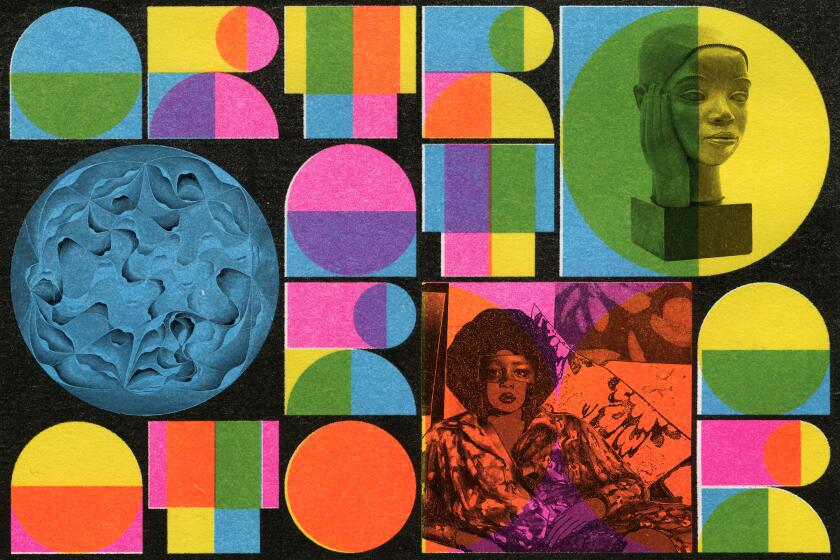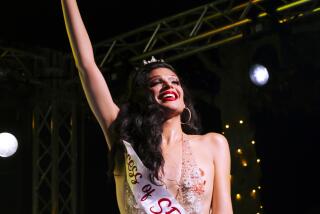Review: Velázquez’s Queen Mariana portrait is a whiz-bang spectacle on view in Pasadena

- Share via
- Madrid’s Prado Museum has loaned a monumental 1653 Diego Velázquez painting to the Norton Simon Museum.
- At 14, Mariana married her uncle, Spain’s King Philip IV, then 44.
- The theatrical portrait has been shown in the United States only once before, in New York in 1989.
Philip IV was in trouble. Spain’s far-flung empire, arguably the world’s most powerful, had seriously wobbled in the 1640s — and so had the king’s family life.
When the bloody Thirty Years’ War that upended European states and alliances finally came to a brutal end, the Dutch Republic had escaped Madrid’s control, while rival France had bested its neighbor across the Pyrenees, coming out on top in European influence. Portugal and Catalonia had revolted. A plague devastated Seville, killing half the population. Prince Baltasar Carlos, Philip’s only son and likely heir to all the king’s dominions, had died at 16, apparently a smallpox victim. Queen Isabella of Bourbon, Philip’s shrewd and beloved wife of nearly 30 years, had succumbed two years before. As bad news piled on bad news, something drastic needed to be done.
Enter Mariana, the subject of an extraordinary, monumental full-length portrait painted by the Spanish genius Diego Rodríguez de Silva y Velázquez, loaned by Madrid’s Prado Museum to Pasadena’s Norton Simon Museum. The work, seen only once before in the United States, in the artist’s landmark 1989 retrospective in New York, is part of a new exchange partnership between the two museums.

For his first non-American subject, documentary filmmaker Ken Burns chose Renaissance polymath Leonardo da Vinci.
The program began in March with the loan to Madrid of the Simon’s signature “Still Life with Lemons, Oranges and a Rose” by Francisco de Zurbarán. That painting has returned to California, and Simon chief curator Emily Talbot and associate curator Maggie Bell have installed it as one among nine works from the museum’s collection — by Jose de Ribera, Bartolomé Esteban Murillo, Peter Paul Rubens, Nicolas Poussin and others — to provide some context for the Velázquez. Art collecting was an important activity at the Habsburg court, signaling power, privilege and complexities of international relationships. The commission for a formal portrait of Mariana of Austria, daughter of the Holy Roman Emperor and Spain’s new queen consort, was a very big deal.
Velázquez was up to the task. Court painter by then for nearly 30 years, he had risen to become one of Europe’s greatest artists. The life-size portrait he produced is a whiz-bang spectacle of courtly pomp and dynastic circumstance. At least three copies of this official state image were made, along with numerous variants — one is in the San Francisco Museum of Fine Arts — a sure sign of its success.
Mariana was barely 18. She had already been married to the king for three years, wedded first by proxy when Philip IV was off at war, and she was still in Vienna, and then in person after her arrival in Spain. When the artist set to work, she had recently born the king a child — the Infanta Margarita, who would later become a central figure in “Las Meninas,” Velázquez’s greatest painting. The union between husband and wife was meant to cement the Spanish and Austrian wings of the sprawling Habsburg Dynasty, a promotional sign of renewed strength after many years of turmoil.
Some complicated urgency framed these events. At 11, Archduchess Mariana had been promised to Baltasar Carlos — her teenage first cousin. After his untimely death, her father wrote Philip a condolence letter suggesting that he, recently widowed by the passing of Isabella, take her as his bride instead. Mariana’s uncle Philip was 44. The arrangement was made.
Amid all this high-stakes imperial drama, theatricality is an appropriate key to the Velázquez portrait, which puts on quite a show.
A luxurious red curtain is raised at the top, just above the young woman’s head, as if Mariana is being publicly unveiled upon a royal stage for our astonished inspection. She steadies herself, with one hand grasping the back of an elaborate carved and upholstered chair at the left, while a tabletop clock at the rear on the opposite side ticks away. The chair indicates “throne,” the austere clock adds a symbolic note of sober timeliness, as well as intimating life’s inevitable transience.
Some air is breathed into the composition’s shallow space by these two simple elements, positioned side to side, front and back. Velázquez drew a straight visual line across the canvas between the throne and the clock. Following left to right it runs directly through the figure of the young queen, positioning Mariana as the royal hinge connecting past, present and future.
And what a figure she is. The girl is costumed to the hilt. Her black velvet dress trimmed in elaborate silver is an eye-grabber. Power dressing doesn’t get more forceful.

The dress is enormous, too, featuring a hidden, outrageously wide scaffolding of rigid undergarments called a guardainfante. A style originating in France, where unmarried women and prostitutes used it to conceal pregnancies, Mariana’s guardainfante skirt is so big that not only does it span the picture’s width, but it also required that Velázquez add a strip of canvas down the left side to accommodate the expanse. (Look at the painting from an angle in raking light, and the sewn-in addition is visible. A second strip, thought to have been added much later, is also evident across the curtain at the top.) Likewise unseen, given the floor length skirt, are her silk and silver-trimmed chapines — high, cork-soled platform shoes that lift up the petite monarch to lend stature.
Mariana does look a bit like a piece of furniture — a human sofa. Crowned by an equally extreme, elaborately decorated wig that matches the bell shaped skirt, she takes up more than ample space. The oversize volume symbolizes her commodious royal position in society.
Its practical function: No one, neither courtier nor plebeian, could stand close to the queen, conspicuous in her splendid isolation.
Velázquez worked with Mateo Aguado, the queen’s brilliant tailor, to dramatically dress the portraiture scene. In an indispensable new book from Yale University Press, “Spanish Fashion in the Age of Velázquez: A Tailor at the Court of Philip IV,” historian Amanda Wunder unearths the long-neglected story of Aguado, an applied artist who toiled for the royal household almost as long as the painter did. Wunder notes that Mariana’s guardainfante dress might be something of a sly jest — an out-of-date foreign fashion, actually banned in Spain by her husband for its immodest associations with wanton women, here donned by a royal new mom.
‘Adam and Eve,’ Ed Ruscha, Mickalene Thomas, Judithe Hernández and Olafur Eliasson lead our art critic’s list of standout art in 2024.
The garment’s austere black and silver palette projects a demure yet powerful mix of luxury and restraint. Her ensemble is accented with abundant gold jewelry and a variety of red splashes in wrist- and hair-bows, brightly rouged cheeks and a feathered headdress. Mariana is having fun, but not too much. She does, after all, hold a critically important job, and her portrait shows her performing it.
Velázquez’s vigorous brushwork is itself a demonstrable performance, designed to seduce and entertain the viewer. Rather than a tight, realist description of sitter and scene, he opted for suggestively rendering the image in quick, loose paint. Not dryly explaining tedious details, he invites the observer’s engaged eye to collaborate in assembling the scene’s visual construction. The painterly technique would inform later generations of artists like Édouard Manet, Cecilia Beaux and John Singer Sargent.
The big skirt could have been a flat, dull “black hole” gobbling up half the painting, but Velázquez magically transformed it into tactile velvet with several soft, squiggly yet relaxed marks of light gray paint. Row upon row of elaborate trimmings are composed of interlocking streams of fluid silver, their chain-like pattern more visually felt than precisely illustrated. In the most flamboyant gesture, a large cascade of lace in watery white oil paint falls from Mariana’s left hand, gently pressed against her velvet dress rather than tightly grasped.
The large, angled handkerchief is a subtle formal echo of the drapery opening diagonally above Mariana’s head. It could almost fill that space like a puzzle piece. Velázquez organized the composition as a centralized cross — vertical queen, horizontal furnishings of chair and clock, overlapped by an “X” of decorative textile motifs.
Is it just coincidence that all these lines intersect over Mariana’s womb, since the young girl’s primary role at Madrid’s court was to provide a Habsburg heir to the Spanish throne? Perhaps that would help explain Aguado’s surprising revival of a pregnancy-themed dress for her official image.

One of the more remarkable features of Velázquez’s stunning pictorial achievement is that he chose to paint Mariana’s portrait over one of many he had already executed of her husband. (The reuse of a narrower existing canvas is why he needed to add a strip to accommodate the queen’s voluminous dress.) An X-ray of the under-painting published by the late Velázquez scholar Jonathan Brown shows that Mariana’s face was painted directly on top of Philip’s.
The House of Habsburg was highly inbred — estimates are that over 80% of marriages within the Spanish branch of the dynasty were between close blood relatives — and both the king and his child bride, an uncle and niece, sported the same long nose, protruding lower lip and so-called “Habsburg jaw.” (Their eventual son, the future Charles II, suffered pronounced physical deformities and mental disabilities and died at just 38.) A few deft changes to Philip’s face made him into Mariana — painting as plastic surgery.
Velázquez could have used a fresh canvas, but he chose not to. Whether he was taking a shortcut or making a point is hard to decide. Whatever the reason, the result is enthralling. With just a small handful of Velázquez paintings in American museums, none west of Texas, the temporary visit of this knockout example by one of history’s premier painters is an opportunity not to miss.
Velasquez's Mariana
Where: Norton Simon Museum, 411 W. Colorado Blvd., Pasadena
When: Thursday-Monday, through March 24
Admission: $15-$20; youths 18 and younger are free
Information: (626) 449-6840,www.nortonsimon.org
More to Read
The biggest entertainment stories
Get our big stories about Hollywood, film, television, music, arts, culture and more right in your inbox as soon as they publish.
You may occasionally receive promotional content from the Los Angeles Times.













